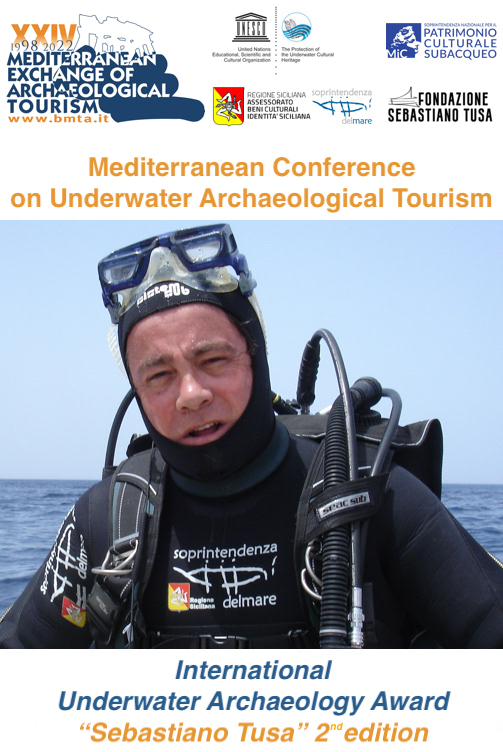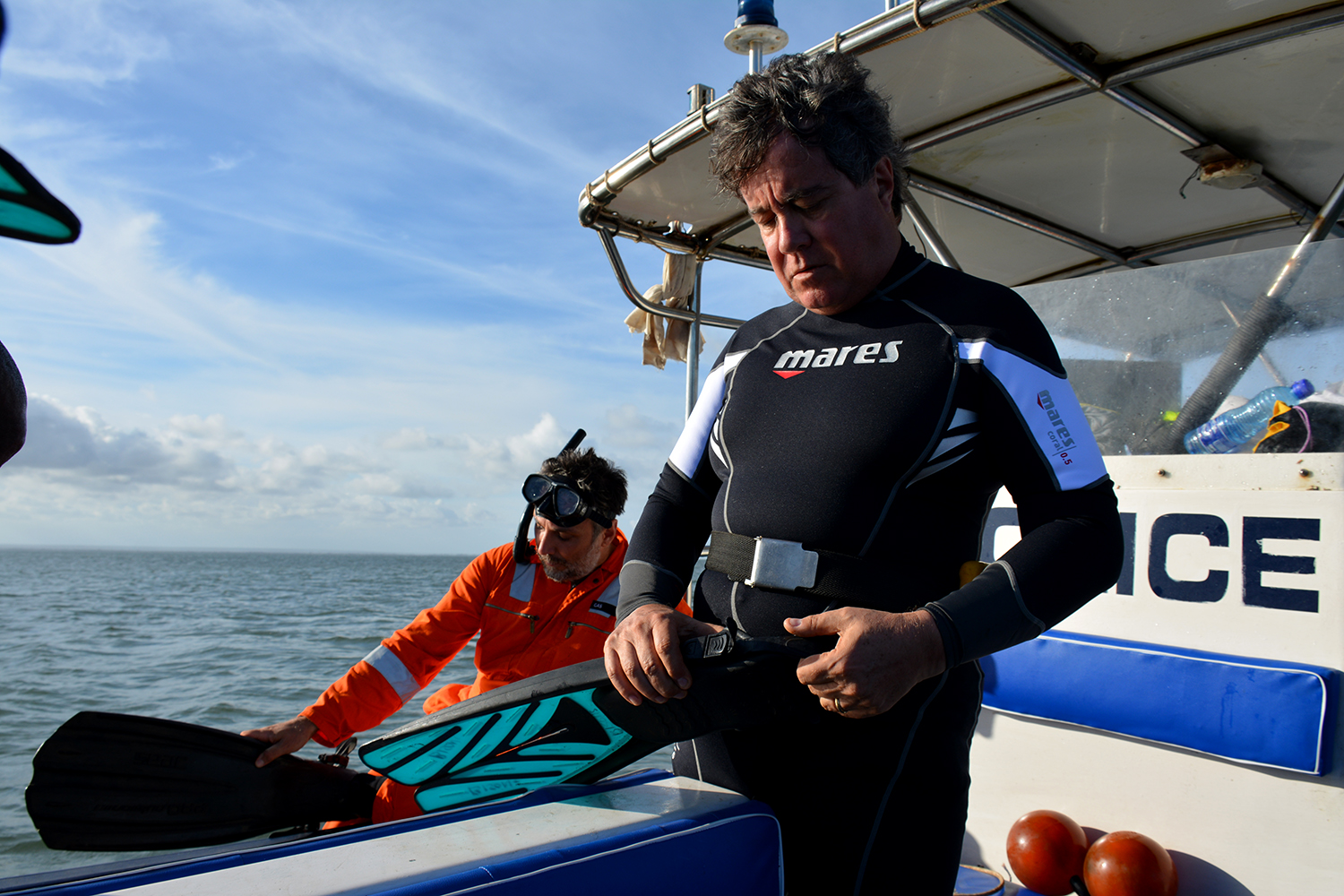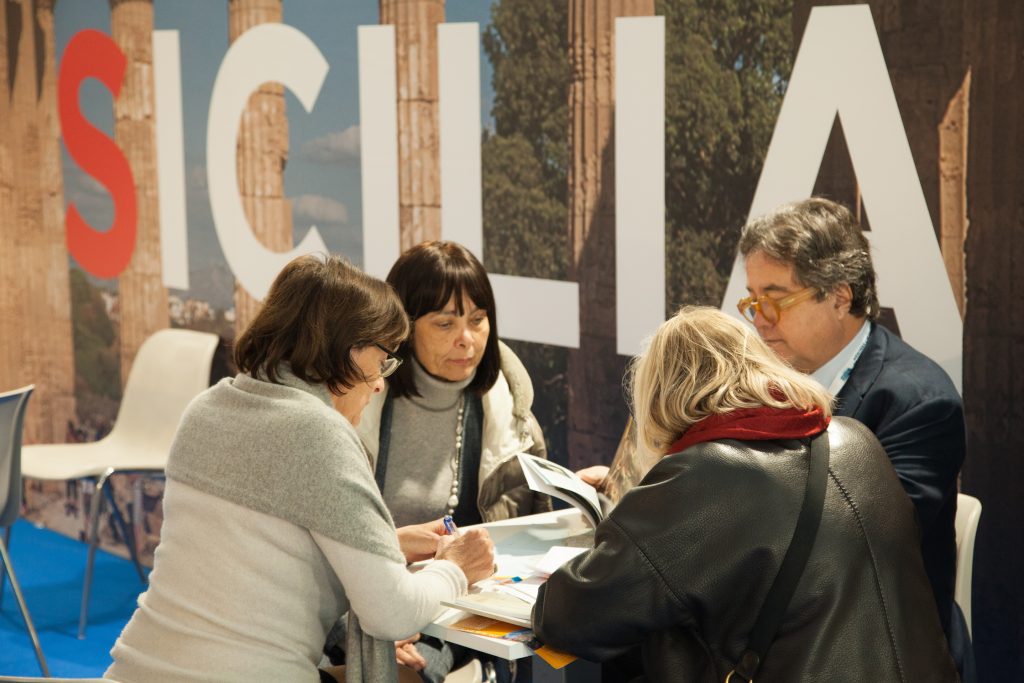During the 2019 edition the Exchange posthumously assigned the “Paestum Archaeology Award” to Sebastiano Tusa, to honor the memory of the great archaeologist, of the scholar, of the friend of the Exchange, but mostly of the man of Southern Italy, who lived his life at the service of the institution to contribute to the local development and the preservation of Mare Nostrum.
Hence, there was the idea of organizing the Mediterranean Conference on Underwater Archaeological Tourism annually, to give great attention to Mediterranean underwater archaeological destinations, and the International Underwater Archaeology Award “Sebastiano Tusa”, aimed at remembering his commitment and his projects.
 During the 1st Conference, on the occasion of the 2021 edition of the Exchange, there was the submission of the certification application for a European Cultural Itinerary “Mediterranean Underwater Cultural Heritage” (a network that will connect Calabria, Campania, Apulia, Sicily, Egypt, Greece, Israel and Turkey through the sites of Capo Rizzuto, Baia Sommersa/Submerged Park of Gaiola, Egnazia/Tremiti Islands/San Pietro in Bevagna, Egadi Islands/Pantelleria/ Plemmirio/Ustica, Alexandria of Egypt, Pavlopetri/Peristera, Caesarea Maritima and Kızlan), which represents a key resource for responsible tourism and sustainable development, responding to the innovative activities and projects requested by the Council of Europe in the framework of the five priority action sectors, strategic for local development and the cultural value of the territories: cooperation in the field of research and development; enhancement of European memory, history and heritage; cultural and educational exchanges for young Europeans; contemporary artistic and cultural practices; cultural tourism and sustainable cultural development.
During the 1st Conference, on the occasion of the 2021 edition of the Exchange, there was the submission of the certification application for a European Cultural Itinerary “Mediterranean Underwater Cultural Heritage” (a network that will connect Calabria, Campania, Apulia, Sicily, Egypt, Greece, Israel and Turkey through the sites of Capo Rizzuto, Baia Sommersa/Submerged Park of Gaiola, Egnazia/Tremiti Islands/San Pietro in Bevagna, Egadi Islands/Pantelleria/ Plemmirio/Ustica, Alexandria of Egypt, Pavlopetri/Peristera, Caesarea Maritima and Kızlan), which represents a key resource for responsible tourism and sustainable development, responding to the innovative activities and projects requested by the Council of Europe in the framework of the five priority action sectors, strategic for local development and the cultural value of the territories: cooperation in the field of research and development; enhancement of European memory, history and heritage; cultural and educational exchanges for young Europeans; contemporary artistic and cultural practices; cultural tourism and sustainable cultural development.
The project is developed starting from the consideration that there are still few underwater itineraries or archaeological areas that are equipped and open to the public, in Italy and internationally. To be honest, many underwater archaeological sites are destination of visits, also guided ones, of local diving clubs, but they are not preserved and, anyway, they lack signage and didactic organization for the visit.
The request of certification of a European Cultural Route to the Council of Europe aims to underline the potentialities of underwater archaeological tourism for the local development of many destinations, even the ones that are far from the most famous localities, for the sake of preservation, authentic experiences and sustainability.
The International Underwater Archaeology Award “Sebastiano Tusa” is assigned to archaeological discovery of the year or lifetime achievement, to the best exhibition of international scientific value, to the most innovative project by Institutions, Archaeological Parks and Museums, to the best educational journalistic contribute in terms of diffusion



In 2023 the Award is assigned to:
lifetime achievement
Katerina Dellaporta former Advisor to the Greek Minister of Culture on underwater archaeology, Director General of the Byzantine and Christian Museum of Athens
For the decisive role played, in the Mediterranean panorama, for the affirmation of underwater archeology as a specific area of protection, research and valorisation.
Her experience successfully supported UNESCO initiatives for underwater archeology around the world. Her constant commitment concerned the various types of submerged sites: from settlements to infrastructures (ports), to both ancient and modern wrecks, contributing to the development of investigation, study and valorisation technologies, but also demonstrating that international cooperation in activities of underwater archeology is one of the most useful paths to undertake to raise awareness of the cultural heritage that the Mediterranean Sea has preserved and how it should be preserved;
for the best exhibition of international scientific value
Romy Wyche Director of the Museum of Ancient Arles and Provence for the Exhibition “Trésors du fond des mers. Un patrimoine archéologique en danger” (October 22nd, 2022 – February 20th, 2023)
The exhibition has the important merit of having combined the display of finds of extraordinary artistic workmanship with the explicit and blunt demonstration of the unsolved problem of protecting the submerged archaeological heritage of the Mediterranean Sea. Pleasure and pain side by side in the same exhibition, which highlights the importance of what the Mediterranean Sea preserved and at the same time lost, loses and still risks losing in the future. It is not enough to open your eyes to beauty, you also need to know that this beauty is threatened by old and new dangers: from theft to irreparable damage due to the intensification of exploitation of the Mediterranean seabed;
for the most innovative project by Institutions, Museums and Archaeological Parks
Massimiliano Marazzi Professor of Cultures of Aegean Sea and Anatolia at University Suor Orsola Benincasa of Naples for Progetto Vivara
An innovative project for the interdisciplinary methodology applied for the first time on a Mediterranean island: Vivara (Municipality of Procida). The novelty of the project is articulated both in the establishment of the “Library of finds” for the benefit of scholars and students and in the construction of a new cartography of the seabed through orthophotogrammetric surveys. The new cartography will be used first and foremost by the Park Authority that manages the Vivara Nature Reserve, as an essential means for the protection and conservation of the entire marine area which is now submerged, and which in the Bronze Age all emerged and was frequented by the inhabitants of the Vivara Island, of which the map of the ancient port will also be reconstructed; underwater archeology and marine ecology work together to protect the Mediterranean Sea;
for the best journalistic contribution in terms of divulgation
Alberto Angela Science popularizer
For his extraordinary contribution to the knowledge of submerged cultural heritage and in particular to underwater archaeological heritage. The underwater archaeology of the Mediterranean Sea, of lakes, rivers and lagoons, in particular the Venice Lagoon, owes to Alberto Angela the correct information on where and how the underwater archaeologist operates, without giving in to the spectacular and sensationalist side alone. The exhaustive information, accompanied by images, which today enrich the documentation of the history of Italian underwater archaeology, can rightfully constitute a manual on how to make the general public aware of what Italian cultural heritage is.
In 2022 the Award has been assigned to:
lifetime achievement
Eric Rieth Director emeritus of CNRS Center National de la Recherche Scientifique in France on behalf of the University Paris 1 Panthéon-Sorbonne-CNRS and Head of the Naval Archeology Department at the National Marine Museum in Paris
Taking a cue from the presentation of Eric Rieth’s latest book by Patrice Pomey, one of the fathers of underwater archeology in the Mediterranean Sea: “The figure and work of Eric Rieth constitute an internationally recognized record, built over the years through profound knowledge of the collections of the National Marine Museum in Paris, as well as its archives, the practice of archeology on the ground, which led him to take an interest in all the sources of naval archeology: archaeological ones in the first place, through the excavation and study of numerous wrecks; historical ones starting obviously from the ancient treatises on naval architecture; iconographic ones for the long attendance of museum collections and models; ethnographic ones, thanks to his knowledge of the work of Admiral Paris, father of naval ethnography”.
for the most innovative project by Institutions, Museums and Archaeological Parks
Andrea Camilli Director of Museum of Ancient Ships of Pisa for project “Grande Tirreno”
The idea for the project was born when Camilli became aware of the complexity of the “naval” archaeological area of Pisa San Rossore. The implementation of the new challenging project starts from the identification of the area where it will be built, an area that concerns a complex system, which physically groups a large part of the S. Vito complex and the Medici Arsenals, with the establishment of three main functional areas, which also gather around them other functions: the Museum of Ancient Ships of Pisa, which currently occupies the complex of the historic Medici arsenals for an area of 4700 square meters, in addition to hosting the restored ships of the excavations of S. Rossore, frames the history of Pisa from its origins to the early Middle Ages and talks about the history of navigation in the classical age; the Centro di Restauro del Legno Bagnato, active elsewhere since 2005 and just moved to the recently restored building, houses the laboratories and it is home to training and university courses on restoration; the Biblioteca delle Navi and the related study centre, currently being set up in the San Vito building, where they will house offices, laboratories and a library dedicated to maritime and naval archaeology, restoration and the history of Pisa.
for the best journalistic contribution in terms of divulgation
Pippo Cappellano Journalist, director, underwater photo cameraman and author of documentaries
Water is his environment, which he will never leave up to the present day, always diving for services from marine biology to underwater archeology, from ethnography of fishing to ethnology of sea peoples. He works with his underwater camera on the bottom of seas, lakes, lagoons, rivers, wherever man has left traces of his history.
In 2021 the Award has been assigned to:
for the archaeological discovery of the year or lifetime achievement
Xavier Nieto Prieto Vice President of the Scientific and Technical Advisory Body of the 2001 UNESCO Convention for the Protection of Underwater Cultural Heritage
For his work of research, protection, and university teaching, promoted over a life spent with competence and passion in the field of underwater archeology. Since 1976 he has participated in underwater archaeological missions in Spain, Italy, France, Morocco, Haiti, Panama. Member and then Vice President of the Scientific and Technical Advisory Body of the 2001 UNESCO Convention for the Protection of Underwater Cultural Heritage, Director of the Center for Underwater Archeology of Catalonia, Director of the National Museum of Underwater Archeology (ARQUÀ), Xavier Nieto Prieto is one of the world’s leading figures for naval and underwater archeology for his research, discoveries, studies, publications, for his constant institutional commitment to the affirmation of underwater archeology as a university discipline, as a specific asset to be protected and enhanced both underwater and in dedicated museums.
for the best exhibition of international scientific value
Paolo Giulierini Director National Archaeological Museum of Naples
For the design, promotion and realization of the exhibition “Thalassa. Wonders submerged by the Mediterranean Sea “December 2019-August 2020. The exhibition, born from an inspired intuition of several scholars, including Sebastiano Tusa who was its first animator and passionate supporter, courageously represented a new way of answering the question “what is the Mediterranean Sea?”. The public was able to see with new eyes an extraordinary reality made up of geological events, ecosystem dynamics, stories and myths, mermaids and heroes, travelers and explorers, transport of food products and luxury goods. The intertwining of the destinies of the Great Sea and the destinies of the coastal populations is represented by the reconstruction over time of the routes followed by the ships that sailed the Mediterranean Sea. The exhibition left an indelible mark on the history of the Museum, which will dedicate a permanent section to the Mediterranean Sea and underwater archeology.
for the most innovative project by Institutions, Museums and Archaeological Parks
Franco Marzatico Superintendent for Cultural Heritage Autonomous Province of Trento
For the design and realization of the Archaeological Nature Park of Fiavé, province of Trento, where one of the most important pile dwellings of prehistoric Europe was found. For the first time, the park gives a lake area the possibility of public use of a large wet-underwater archaeological area. Made in a setting that boasts three UNESCO recognitions (prehistoric pile dwellings in the Alps, natural site of the Dolomites, Biosphere Alpi Ledrensi and Judicaria), it offers an innovative and scenographic educational and experiential path with a strong emotional impact, thanks to the reconstruction, as close as possible to the reality of excavation documentation, prehistoric pile-dwelling villages and their ingenious foundations. The dialogue between archeology and natural environment increases knowledge and cultural awareness and it promotes the attractiveness and ecosystem development of the area.
for the best journalistic contribution in terms of divulgation
Donatella Bianchi RAI journalist host of “Lineablu” and President WWF Italy
For her decades of activity as journalist dedicated to spreading knowledge of the Mediterranean Sea, its environment, its culture, its populations, its history. In her tireless work she has always followed every discovery, every research campaign, every character of Mediterranean underwater archeology, anticipating with exemplary tact the real possibility of introducing an environmental and archaeological underwater tourism inspired by the knowledge, protection and conservation of the blue world that embraces Italy. From 1994 to 2020 Linea Blu is today the most important image archive of our sea.
